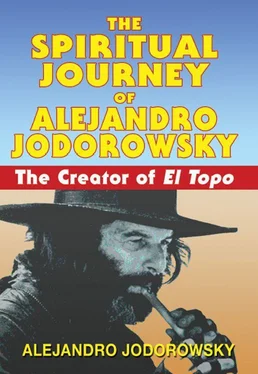“Don’t worry about it. Ejo sees your essential being.”
At the zendo, Ejo took Fernando by the chin affectionately, looked at his teeth, sighed deeply, and said, “One day, you will have very beautiful eyes.”
From that time on, Molina kept his mouth shut tightly, decided to remain mute for the rest of his life, and moved into the zendo, sleeping on the meditation platform. He kept the place impeccably swept and mopped, whitewashed the walls, and cooked rice. Later, he helped Michiko rid the plants of parasites; accompanied Tomiko to school; cleaned the cat box; was allowed to walk among the meditating disciples, brandishing the kyosaku and slapping the shoulder blades of the drowsy ones with slumping backs; made trips to the market to scavenge leftover fruits and vegetables; and did many other things.
Touched by such devotion, Ejo was full of hope, imagining a future in which the ancient cultures of Japan and Mexico would come together in a religious embrace. When Fernando’s head was shaved and he donned the robes of a monk, Ejo wrote a poem:
He who has no arms
will help with his arms
and he who has no legs
will help with his legs
in this great spiritual work
where many beings
will lose their hair.
Shortly afterward, Ejo decided to send his first Mexican monk to the same monastery where he had been trained. At this news, Molina let out a great neigh of pleasure, showing his teeth for the first time in a year. All of us contributed money to help purchase the airplane ticket, most of which had been paid for by a contribution from the Japanese embassy.
A month later, the master received a card from Mumon Yamanda congratulating him on having trained such an exemplary monk who outdid even his Japanese disciples in his devotion to daily tasks and meditation.
Later, Ejo returned again to Japan. When he arrived at the monastery, it was as if he was drenched with a huge bucket of cold water. The very day he went to visit his old master, the monks who had the job of supervising the letters and packages that novices received from their families had made an unpleasant discovery: concealed in the boxes of chocolates that Molina had been receiving from Mexico were several types of drugs, including opium paste, heroin, and LSD. Worse, they discovered that a part of the package contents had been set aside for the purpose of selling drugs to the other novices.
Thus the first Mexican monk was expelled in disgrace and forbidden to enter any Zen monastery or temple in Japan.
Judging from the terrible rage that Ejo manifested in the zendo upon his return, his shame and disappointment must have been immense. Molina had already returned from Japan, taking a plane that left only two hours before his. Acting as if nothing had happened, Fernando was still wearing his monk’s robes and sleeping soundly next to Ana Perla. Mingled with the fragrances of incense — sandalwood, patchouli, and myrrh — was a strong odor of marijuana.
Standing motionless for a moment before this spectacle, Ejo suddenly burst into a flurry of raging action. Swinging his stick, he smashed all the flower vases, the pre-Columbian sculptures, the Shivas and the Shaktis, *19and the gilded Buddhas. He ripped from the walls all the kabbalistic and astrological posters and removed the cat’s robe and tossed it out the window. He also tossed out all the zafus, which, formerly black, had been covered with white cloths and embroidered with Huichol designs.
Then he proceeded to expel Ana Perla and the others who were in the zendo, threatening them with fists and feet. Terrified, they all fled in haste. Only Fernando Molina remained, sitting hunched in a ball, his head between his legs and his arms clasped tightly. Ejo rolled him out the door, into the middle of the street, but Molina refused to budge. He remained there in a ball, with cars swerving to avoid him, and there he stayed for hours, yet the master’s compassion seemed to have vanished. Finally, an ambulance arrived. They placed him on a stretcher, still rolled in a ball, and took him away.
We never saw him again. (Three years later, I learned that Molina had appeared in a “happening,” now endowed with normal teeth. His new act consisted of burning a monk’s robe and copulating with his wife upon its ashes before a large audience.)
Late that night, Ana Perla sneaked back to the zendo, accompanied by six of her acolytes, and painted this graffiti upon its facade in huge red letters: BUDDHA IS A WOMAN.
During this dismal period, I decided imprudently to read to the master the following essay, which I had just published in the cultural supplement of the conservative periodical Heraldo de Mexico .
Donald Duck and Zen Buddhism
There exists a Donald Duck comic that corresponds exactly to the message of koans 42 and 44 of the book of Mumonkan. *20
The city fire chief invites Donald to join the volunteer firefighters. He tells his three nephews about it. They want to join too, but their uncle considers them incompetent and orders them to stay at home. Donald is provided with a complete uniform on condition that he rush immediately to the scene of the fire as soon as he hears the alarm. If he arrives in time, he will receive a bronze medal. Proudly, Donald empties a chest, saying he’ll need the space for all the medals he is bound to receive. That night, the alarm rings, but he sleeps through it. His nephews drag him out of his sleep. He hurries to the fire but forgets his helmet. He also forgets his hatchet and his pants. When he finally arrives with these items, it is too late. The house he was supposed to save is a mass of smoking ruins, and the other firefighters have left.
The next day, the chief demotes him, taking away his hatchet and replacing it with a small extinguisher. That night, the alarm rings again, and once more, his nephews have to drag him out of sleep. This time he dresses more carefully, but in his haste, he grabs a can of insecticide instead of the extinguisher. When he sprays it on the fire, it only makes the flames worse.
The chief demotes him again. From now on, he has only a sack to use against the fire. Wanting to help him, his nephews decide to set a small fire so that he will not be too depressed and will have work to do. Meanwhile, Donald discovers a package of fireworks, including rockets. Thinking they are dangerous, he stuffs them in his coat pockets.
“Uncle Donald, there’s a fire in the street! You must take your sack and save the town!”
Donald succeeds in putting out the flames, but his coat catches fire and he runs home. The rockets explode there and his living room catches on fire. The nephews put it out with a hose.
The chief arrives and is impressed by the nephews. He invites them to join the firefighters. The next night, when the alarm sounds, the nephews wake up, shouting: “We must go quickly! Nothing can stand in our way!” They rush off toward the fire in a modern, fully equipped fire truck. Meanwhile, poor Donald is left standing in the street with his pathetic sack, watching the truck speed away. “They have all the luck,” he mutters.
Several esoteric teachings point out the error that causes us to link all our ordinary states of consciousness, forgetting that they are separated by vast lakes of sleep. Zen is based upon a total awakening known as satori .
Satori is the alpha and omega of Zen Buddhism. It may be defined as intuitive insight into the nature of things, as opposed to logical or analytic understanding. In practice, it signifies the discovery of a new world heretofore unnoticed because of the confusion of a mind educated in dualism. When we experience satori, everything around us is seen with a kind of perception that has never before been known. .
Читать дальше












